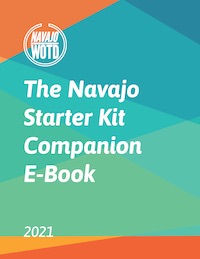beh
Bee is one of a group of words that translates to “with or by means of (it).” Using it takes some practice, but it’s essential knowledge. Here’s an overview.
For reference: Shee would mean “with me”, nee means “with you”, and bee takes its place in the third person “with him/her/it”. These words follow special rules that makes bee (or yee – the other 3rd person form) relatively common.
In English grammar, the word ‘with’ is called a preposition. Prepositions usually come before nouns (people, places or things). For example: “Cook eggs with butter.”
In Navajo, however, these words are postpositions. They follow the noun. Rearranging the earlier example to fit Navajo sentence structure: “Eggs butter with cook,” or “Butter with eggs cook.”
In actual Navajo: “Ayęęzhii mándígíiya bee sit’é,” or “Mandagíiya bee ayęęzhii sit’é.” [eggs butter-with it-is-cooked, butter-with eggs it-is-cooked.]
You’ll notice the with (postposition) word follows the butter (object) word and not the egg (subject) word. And of course, the verb follows everything.
It takes some time to comprehend, but just remember that bee follows the thing that is with the other thing in the sentence. It’s also useful to use bee to mean “by means of it.”
For example:
- “I am going to Flagstaff by means of a vehicle .”
- In Navajo sentence structure: “Flagstaff vehicle by-means-of-it I-am-going.”
- In Navajo: “Kinłánígóó chidí bee déyá.”
Tip: One of the best ways to get a hold of Navajo is to practice rearranging sentences in your mind. You can get started by putting the verb at the end, taking note of the point of view and tense. (ex. “I run,” “she cooked,” “they talk,” “you read,” are one word in Navajo).
For reference, here are some previous posts for words we used:
